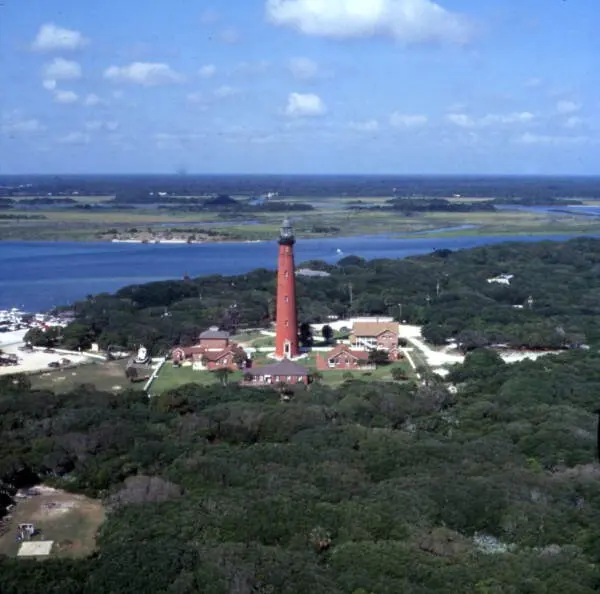At 175 feet, the Ponce Inlet Lighthouse is the tallest lighthouse in Florida.
In the United States, only North Carolina’s Cape Hatteras Lighthouse and Virginia’s Cape Charles Lighthouse are taller.
Many people who brave the 203 steps to get to the top of the structure have a more difficult time coming down than going up.
“We have to talk them down. Some people come down backwards on the stairway. Some come down on the seat of their pants. It’s quite a sight to see,” says Bob Callister, programs manager for the Ponce Inlet Light Station. “Most people really enjoy, once they get up to the top and feel the cool air and see the beautiful view.”
On a clear day, you can see all the way to the Cape Canaveral Lighthouse.
Ponce de León Inlet, popularly known as Ponce Inlet, was known as Mosquito Inlet when the red brick lighthouse was first constructed in 1835. When the Second Seminole War started later that year, the lighthouse was attacked before the lamp could be lit. The Seminoles destroyed the glass lantern and burned the structure’s wooden stairs. The threat of further attacks prevented repairs from being made, and the lighthouse collapsed in 1836.
Many shipwrecks occurred along the shoreline south of Daytona Beach, but construction did not begin on a new lighthouse at Mosquito Inlet until 1883. On November 1, 1887, Russian immigrant and Confederate war veteran William Rowlinski lit the lighthouse lamp for the first time. The light could be seen by ships 20 miles from shore.
The Ponce Inlet Lighthouse helped to save the life of writer and journalist Stephen Crane in 1897. Crane was aboard the SS Commodore on his way to cover the pending revolt in Cuba when the ship sank off of Florida’s east coast. Crane and several crewmen escaped in a small dinghy and followed the signal from the lighthouse to safety after several days at sea.
Crane, best known for his Civil War novel “The Red Badge of Courage,” wrote about his harrowing shipwreck experience in the short story “The Open Boat.”
The lighthouse signal that saved Crane and his companions was lit by kerosene. That lamp was replaced with an incandescent oil vapor lamp in 1909. An electrified 500-watt lamp was installed in 1933. At the same time, the lens that provided a steady beam of light was replaced with a rotating lens. An extensive collection of restored lighthouse lenses is displayed at the Ponce Inlet Light Station, including the 1860 rotating first order Frensel lens from the Cape Canaveral Lighthouse.
The name of Mosquito Inlet was changed to Ponce de León Inlet in 1927. From 1939 until 1970, the Coast Guard operated the Ponce Inlet Light Station. In 1972, the Lighthouse Preservation Association was formed to restore and operate the complex and the lighthouse was placed on the National Register of Historic Places.
In 1998, the Ponce Inlet Lighthouse became one of only ten lighthouses to be designated as a National Historic Landmark.
Today, the Ponce Inlet Light Station includes eight of the original 1887 buildings from the site, including the lighthouse. Three buildings that were used as houses for the lighthouse keeper and his family are now home to exhibits. The displays focus on local history and demonstrate what life was like in the 1800s.
“It’s probably the most complete, restored light station in the United States,” says Bob Callister. “We have had a lot of people here over the years who have commented on how beautifully the buildings are restored, how beautiful the gardens are kept.”
The Ponce Inlet Lighthouse and Museum is open to the public every day except Thanksgiving and Christmas. The complex is open from 10:00 am until 9:00 pm throughout the summer, and from 10:00 am to 6:00 pm from September 2 through May 25.
You can celebrate National Lighthouse Day on Thursday, August 7, by visiting the Ponce Inlet Lighthouse, touring the museum, and participating in special activities for all ages.
If you’re brave enough, you can climb the 203 steps to the top of the lighthouse to enjoy the bird’s-eye view. Just remember that old saying, “what goes up, must come down.”
Dr. Ben Brotemarkle is executive director of the Florida Historical Society and host of the radio program “Florida Frontiers,” broadcast locally on 90.7 WMFE Thursday evenings at 6:30 and Sunday afternoons at 4:00, and on 89.5 WFIT Sunday mornings at 7:00. The show can be heard online at myfloridahistory.org.
